Economics Assignment with 20 Questions
VerifiedAdded on 2021/04/21
|9
|2673
|229
AI Summary
This assignment consists of 20 questions that cover various concepts in economics. The first question requires identifying a suitable title for a book that discusses the impact of climate change on global supply chains. The second question asks about the economic concept related to the idea that firms that are able to produce at lower costs will be more profitable. Other questions include topics such as the Coase theorem, law of increasing returns, tragedy of commons, negative externality, and a scenario involving an upstream firm polluting a river and its impact on a downstream firm.
Contribute Materials
Your contribution can guide someone’s learning journey. Share your
documents today.

Running head: ECONOMICS
1) In the loanable funds model and the neoclassical macroeconomic model
a. Savings always equal Investment but unemployment can occur in the long
run.
b. Savings and Investment are rarely equal and the economy is usually in a
disequilbrium state.
c. The interest rate adjusts to ensure savings equal investment.
d. Savings responds to changes in interest rates but Investment does not and
leakages can be greater than injections.
According to the keynsian model, though there will be market equilibrium, however
unemployment will also be presnt in the economy (Keynses 2016).
2) Assuming no government or foreign sector, if the MPC is 0.8, the multiplier is_______,
and a decrease in consumption of $20 billion will __________ the level of GDP
by_________.
a. 0.8, increase, $20b.
b. 5, decrease, $100b.
c. 0.8, decrease, $20b.
d. 5, increase, $100b.
Multiplier can be calculated by the ratio of change in output induced through
autonomous change in expenditure.
Multiplier is: 1/ (1-MPC)
= 1/ (1-0.8)
= 1/0.2
= 5
Decrease in consumption will lead to decrease in consumer expenditure. Thus it
will lead to fall in the GDP of the economy too.
Reduction in GDP = multiplier x fall in expenditure
= 5 x (-20)
= 100
Therefore fall in consumption will lead to decrease the level of GDP by $100b.
1) In the loanable funds model and the neoclassical macroeconomic model
a. Savings always equal Investment but unemployment can occur in the long
run.
b. Savings and Investment are rarely equal and the economy is usually in a
disequilbrium state.
c. The interest rate adjusts to ensure savings equal investment.
d. Savings responds to changes in interest rates but Investment does not and
leakages can be greater than injections.
According to the keynsian model, though there will be market equilibrium, however
unemployment will also be presnt in the economy (Keynses 2016).
2) Assuming no government or foreign sector, if the MPC is 0.8, the multiplier is_______,
and a decrease in consumption of $20 billion will __________ the level of GDP
by_________.
a. 0.8, increase, $20b.
b. 5, decrease, $100b.
c. 0.8, decrease, $20b.
d. 5, increase, $100b.
Multiplier can be calculated by the ratio of change in output induced through
autonomous change in expenditure.
Multiplier is: 1/ (1-MPC)
= 1/ (1-0.8)
= 1/0.2
= 5
Decrease in consumption will lead to decrease in consumer expenditure. Thus it
will lead to fall in the GDP of the economy too.
Reduction in GDP = multiplier x fall in expenditure
= 5 x (-20)
= 100
Therefore fall in consumption will lead to decrease the level of GDP by $100b.
Secure Best Marks with AI Grader
Need help grading? Try our AI Grader for instant feedback on your assignments.
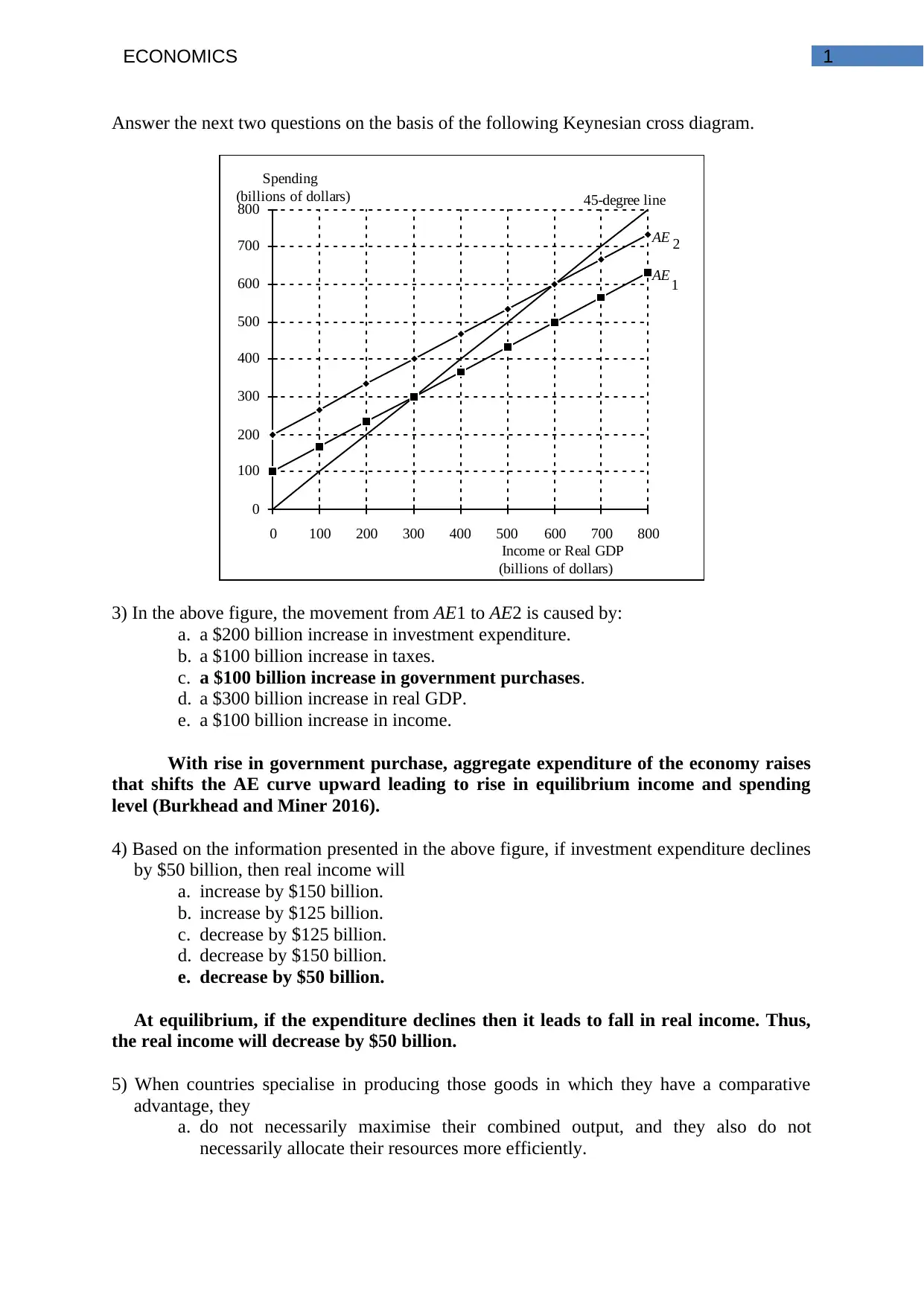
1ECONOMICS
Answer the next two questions on the basis of the following Keynesian cross diagram.
0
100
200
300
400
500
600
700
800
0 100 200 300 400 500 600 700 800
45-degree line
AE
AE
Spending
(billions of dollars)
Income or Real GDP
(billions of dollars)
2
1
3) In the above figure, the movement from AE1 to AE2 is caused by:
a. a $200 billion increase in investment expenditure.
b. a $100 billion increase in taxes.
c. a $100 billion increase in government purchases.
d. a $300 billion increase in real GDP.
e. a $100 billion increase in income.
With rise in government purchase, aggregate expenditure of the economy raises
that shifts the AE curve upward leading to rise in equilibrium income and spending
level (Burkhead and Miner 2016).
4) Based on the information presented in the above figure, if investment expenditure declines
by $50 billion, then real income will
a. increase by $150 billion.
b. increase by $125 billion.
c. decrease by $125 billion.
d. decrease by $150 billion.
e. decrease by $50 billion.
At equilibrium, if the expenditure declines then it leads to fall in real income. Thus,
the real income will decrease by $50 billion.
5) When countries specialise in producing those goods in which they have a comparative
advantage, they
a. do not necessarily maximise their combined output, and they also do not
necessarily allocate their resources more efficiently.
Answer the next two questions on the basis of the following Keynesian cross diagram.
0
100
200
300
400
500
600
700
800
0 100 200 300 400 500 600 700 800
45-degree line
AE
AE
Spending
(billions of dollars)
Income or Real GDP
(billions of dollars)
2
1
3) In the above figure, the movement from AE1 to AE2 is caused by:
a. a $200 billion increase in investment expenditure.
b. a $100 billion increase in taxes.
c. a $100 billion increase in government purchases.
d. a $300 billion increase in real GDP.
e. a $100 billion increase in income.
With rise in government purchase, aggregate expenditure of the economy raises
that shifts the AE curve upward leading to rise in equilibrium income and spending
level (Burkhead and Miner 2016).
4) Based on the information presented in the above figure, if investment expenditure declines
by $50 billion, then real income will
a. increase by $150 billion.
b. increase by $125 billion.
c. decrease by $125 billion.
d. decrease by $150 billion.
e. decrease by $50 billion.
At equilibrium, if the expenditure declines then it leads to fall in real income. Thus,
the real income will decrease by $50 billion.
5) When countries specialise in producing those goods in which they have a comparative
advantage, they
a. do not necessarily maximise their combined output, and they also do not
necessarily allocate their resources more efficiently.
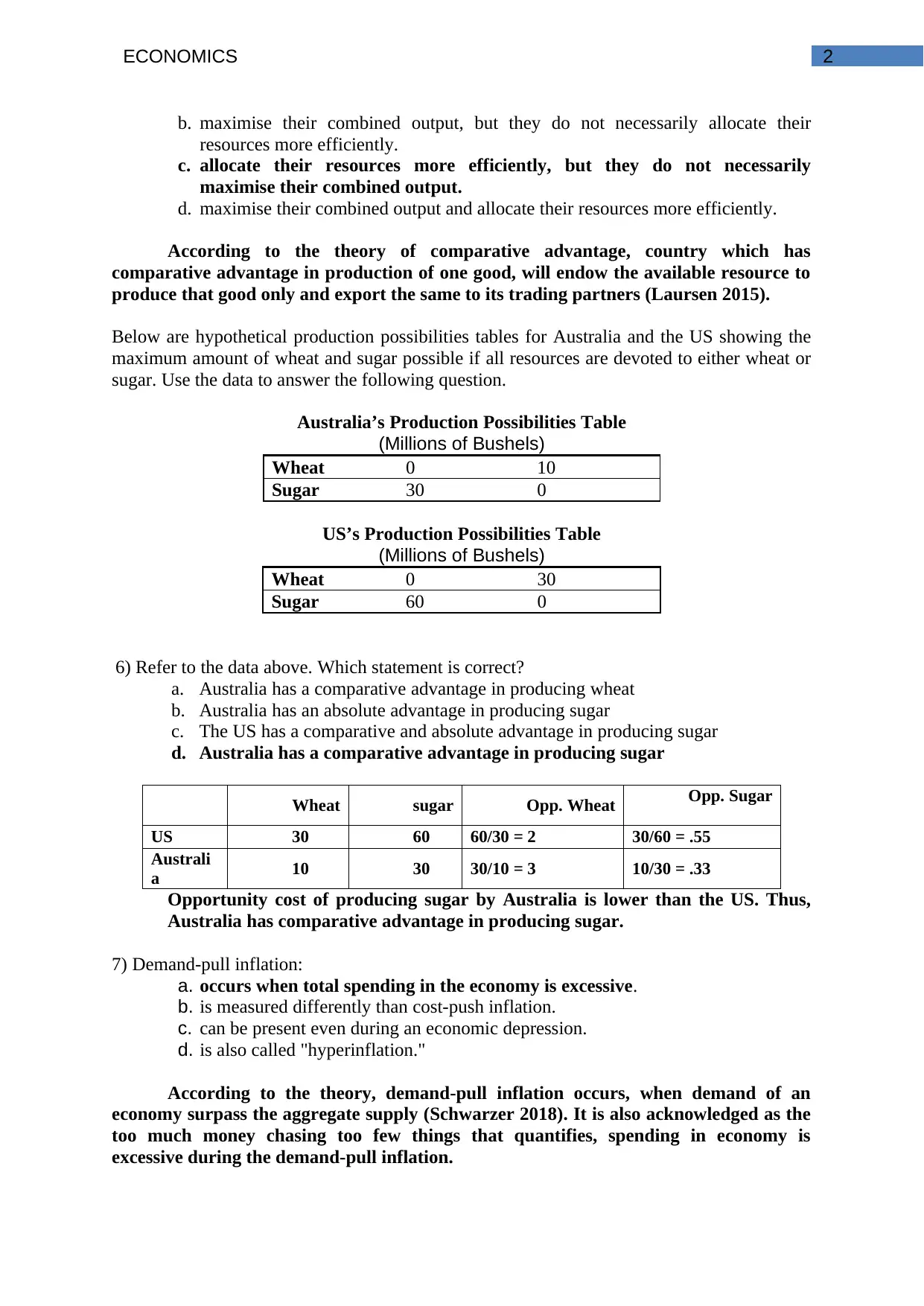
2ECONOMICS
b. maximise their combined output, but they do not necessarily allocate their
resources more efficiently.
c. allocate their resources more efficiently, but they do not necessarily
maximise their combined output.
d. maximise their combined output and allocate their resources more efficiently.
According to the theory of comparative advantage, country which has
comparative advantage in production of one good, will endow the available resource to
produce that good only and export the same to its trading partners (Laursen 2015).
Below are hypothetical production possibilities tables for Australia and the US showing the
maximum amount of wheat and sugar possible if all resources are devoted to either wheat or
sugar. Use the data to answer the following question.
Australia’s Production Possibilities Table
(Millions of Bushels)
Wheat 0 10
Sugar 30 0
US’s Production Possibilities Table
(Millions of Bushels)
Wheat 0 30
Sugar 60 0
6) Refer to the data above. Which statement is correct?
a. Australia has a comparative advantage in producing wheat
b. Australia has an absolute advantage in producing sugar
c. The US has a comparative and absolute advantage in producing sugar
d. Australia has a comparative advantage in producing sugar
Wheat sugar Opp. Wheat Opp. Sugar
US 30 60 60/30 = 2 30/60 = .55
Australi
a 10 30 30/10 = 3 10/30 = .33
Opportunity cost of producing sugar by Australia is lower than the US. Thus,
Australia has comparative advantage in producing sugar.
7) Demand-pull inflation:
a. occurs when total spending in the economy is excessive.
b. is measured differently than cost-push inflation.
c. can be present even during an economic depression.
d. is also called "hyperinflation."
According to the theory, demand-pull inflation occurs, when demand of an
economy surpass the aggregate supply (Schwarzer 2018). It is also acknowledged as the
too much money chasing too few things that quantifies, spending in economy is
excessive during the demand-pull inflation.
b. maximise their combined output, but they do not necessarily allocate their
resources more efficiently.
c. allocate their resources more efficiently, but they do not necessarily
maximise their combined output.
d. maximise their combined output and allocate their resources more efficiently.
According to the theory of comparative advantage, country which has
comparative advantage in production of one good, will endow the available resource to
produce that good only and export the same to its trading partners (Laursen 2015).
Below are hypothetical production possibilities tables for Australia and the US showing the
maximum amount of wheat and sugar possible if all resources are devoted to either wheat or
sugar. Use the data to answer the following question.
Australia’s Production Possibilities Table
(Millions of Bushels)
Wheat 0 10
Sugar 30 0
US’s Production Possibilities Table
(Millions of Bushels)
Wheat 0 30
Sugar 60 0
6) Refer to the data above. Which statement is correct?
a. Australia has a comparative advantage in producing wheat
b. Australia has an absolute advantage in producing sugar
c. The US has a comparative and absolute advantage in producing sugar
d. Australia has a comparative advantage in producing sugar
Wheat sugar Opp. Wheat Opp. Sugar
US 30 60 60/30 = 2 30/60 = .55
Australi
a 10 30 30/10 = 3 10/30 = .33
Opportunity cost of producing sugar by Australia is lower than the US. Thus,
Australia has comparative advantage in producing sugar.
7) Demand-pull inflation:
a. occurs when total spending in the economy is excessive.
b. is measured differently than cost-push inflation.
c. can be present even during an economic depression.
d. is also called "hyperinflation."
According to the theory, demand-pull inflation occurs, when demand of an
economy surpass the aggregate supply (Schwarzer 2018). It is also acknowledged as the
too much money chasing too few things that quantifies, spending in economy is
excessive during the demand-pull inflation.
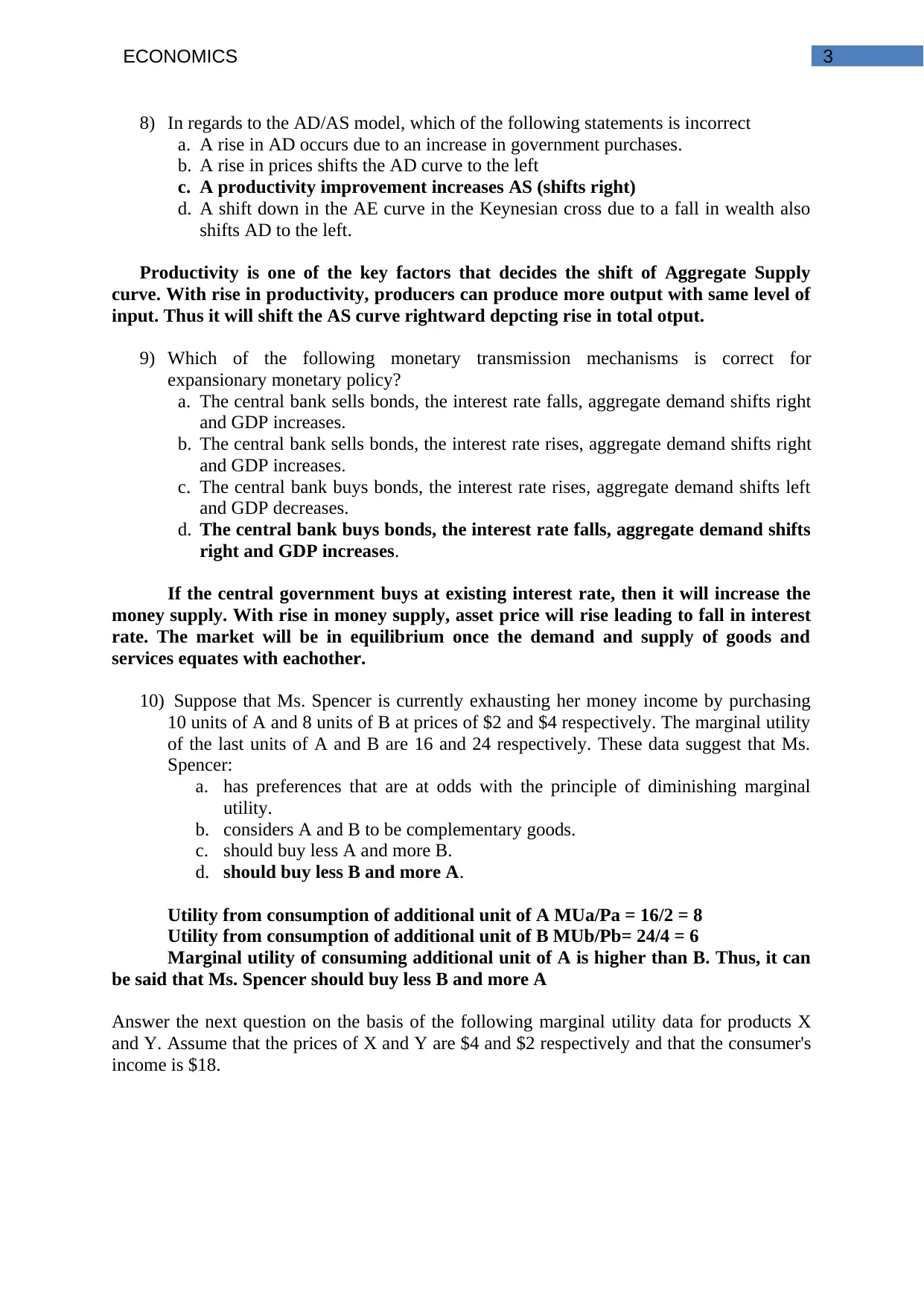
3ECONOMICS
8) In regards to the AD/AS model, which of the following statements is incorrect
a. A rise in AD occurs due to an increase in government purchases.
b. A rise in prices shifts the AD curve to the left
c. A productivity improvement increases AS (shifts right)
d. A shift down in the AE curve in the Keynesian cross due to a fall in wealth also
shifts AD to the left.
Productivity is one of the key factors that decides the shift of Aggregate Supply
curve. With rise in productivity, producers can produce more output with same level of
input. Thus it will shift the AS curve rightward depcting rise in total otput.
9) Which of the following monetary transmission mechanisms is correct for
expansionary monetary policy?
a. The central bank sells bonds, the interest rate falls, aggregate demand shifts right
and GDP increases.
b. The central bank sells bonds, the interest rate rises, aggregate demand shifts right
and GDP increases.
c. The central bank buys bonds, the interest rate rises, aggregate demand shifts left
and GDP decreases.
d. The central bank buys bonds, the interest rate falls, aggregate demand shifts
right and GDP increases.
If the central government buys at existing interest rate, then it will increase the
money supply. With rise in money supply, asset price will rise leading to fall in interest
rate. The market will be in equilibrium once the demand and supply of goods and
services equates with eachother.
10) Suppose that Ms. Spencer is currently exhausting her money income by purchasing
10 units of A and 8 units of B at prices of $2 and $4 respectively. The marginal utility
of the last units of A and B are 16 and 24 respectively. These data suggest that Ms.
Spencer:
a. has preferences that are at odds with the principle of diminishing marginal
utility.
b. considers A and B to be complementary goods.
c. should buy less A and more B.
d. should buy less B and more A.
Utility from consumption of additional unit of A MUa/Pa = 16/2 = 8
Utility from consumption of additional unit of B MUb/Pb= 24/4 = 6
Marginal utility of consuming additional unit of A is higher than B. Thus, it can
be said that Ms. Spencer should buy less B and more A
Answer the next question on the basis of the following marginal utility data for products X
and Y. Assume that the prices of X and Y are $4 and $2 respectively and that the consumer's
income is $18.
8) In regards to the AD/AS model, which of the following statements is incorrect
a. A rise in AD occurs due to an increase in government purchases.
b. A rise in prices shifts the AD curve to the left
c. A productivity improvement increases AS (shifts right)
d. A shift down in the AE curve in the Keynesian cross due to a fall in wealth also
shifts AD to the left.
Productivity is one of the key factors that decides the shift of Aggregate Supply
curve. With rise in productivity, producers can produce more output with same level of
input. Thus it will shift the AS curve rightward depcting rise in total otput.
9) Which of the following monetary transmission mechanisms is correct for
expansionary monetary policy?
a. The central bank sells bonds, the interest rate falls, aggregate demand shifts right
and GDP increases.
b. The central bank sells bonds, the interest rate rises, aggregate demand shifts right
and GDP increases.
c. The central bank buys bonds, the interest rate rises, aggregate demand shifts left
and GDP decreases.
d. The central bank buys bonds, the interest rate falls, aggregate demand shifts
right and GDP increases.
If the central government buys at existing interest rate, then it will increase the
money supply. With rise in money supply, asset price will rise leading to fall in interest
rate. The market will be in equilibrium once the demand and supply of goods and
services equates with eachother.
10) Suppose that Ms. Spencer is currently exhausting her money income by purchasing
10 units of A and 8 units of B at prices of $2 and $4 respectively. The marginal utility
of the last units of A and B are 16 and 24 respectively. These data suggest that Ms.
Spencer:
a. has preferences that are at odds with the principle of diminishing marginal
utility.
b. considers A and B to be complementary goods.
c. should buy less A and more B.
d. should buy less B and more A.
Utility from consumption of additional unit of A MUa/Pa = 16/2 = 8
Utility from consumption of additional unit of B MUb/Pb= 24/4 = 6
Marginal utility of consuming additional unit of A is higher than B. Thus, it can
be said that Ms. Spencer should buy less B and more A
Answer the next question on the basis of the following marginal utility data for products X
and Y. Assume that the prices of X and Y are $4 and $2 respectively and that the consumer's
income is $18.
Secure Best Marks with AI Grader
Need help grading? Try our AI Grader for instant feedback on your assignments.

4ECONOMICS
U n its M a r g in a l U n its M a r g in a l
o f X u tility, X o f Y u tility, Y
1 2 0 1 1 6
2 1 6 2 1 4
3 1 2 3 1 2
4 8 4 1 0
5 6 5 8
6 4 6 6
11) Refer to the above data. What quantities of X and Y should be purchased to maximize
utility?
a. 2 of X and 1 of Y
b. 4 of X and 5 of Y
c. 2 of X and 5 of Y
d. 2 of X and 6 of Y
2 unit of X: price = $8 and utility = 32
5 unit of Y: price = $10 and utility = 40
Total budget $18 and total utility is 72
Utility can be maximized through this option only.
12) Which of the following is most likely to be a variable cost?
a. fuel and power payments
b. interest on business loans
c. rental payments on IBM equipment
d. real estate taxes
Material costs and labor cost are subject to fluctuation, thus these are
acknowledged as the variable cost.
Answer the next question on the basis of the following cost data:
Output Total
cost
1 40
2 54
3 87
4 124
5 190
13) Refer to the above data. Given a price of $33, the profit-maximizing level of output for
this firm:
a. is 3.
b. is 4.
c. is 5.
d. cannot be determined from the information given.
Revenue (∏) = p*q – total cost
Utilizing First order condition of profit maximizing, it can be found that highest
profit can be achieved through producing 3 units of good.
U n its M a r g in a l U n its M a r g in a l
o f X u tility, X o f Y u tility, Y
1 2 0 1 1 6
2 1 6 2 1 4
3 1 2 3 1 2
4 8 4 1 0
5 6 5 8
6 4 6 6
11) Refer to the above data. What quantities of X and Y should be purchased to maximize
utility?
a. 2 of X and 1 of Y
b. 4 of X and 5 of Y
c. 2 of X and 5 of Y
d. 2 of X and 6 of Y
2 unit of X: price = $8 and utility = 32
5 unit of Y: price = $10 and utility = 40
Total budget $18 and total utility is 72
Utility can be maximized through this option only.
12) Which of the following is most likely to be a variable cost?
a. fuel and power payments
b. interest on business loans
c. rental payments on IBM equipment
d. real estate taxes
Material costs and labor cost are subject to fluctuation, thus these are
acknowledged as the variable cost.
Answer the next question on the basis of the following cost data:
Output Total
cost
1 40
2 54
3 87
4 124
5 190
13) Refer to the above data. Given a price of $33, the profit-maximizing level of output for
this firm:
a. is 3.
b. is 4.
c. is 5.
d. cannot be determined from the information given.
Revenue (∏) = p*q – total cost
Utilizing First order condition of profit maximizing, it can be found that highest
profit can be achieved through producing 3 units of good.
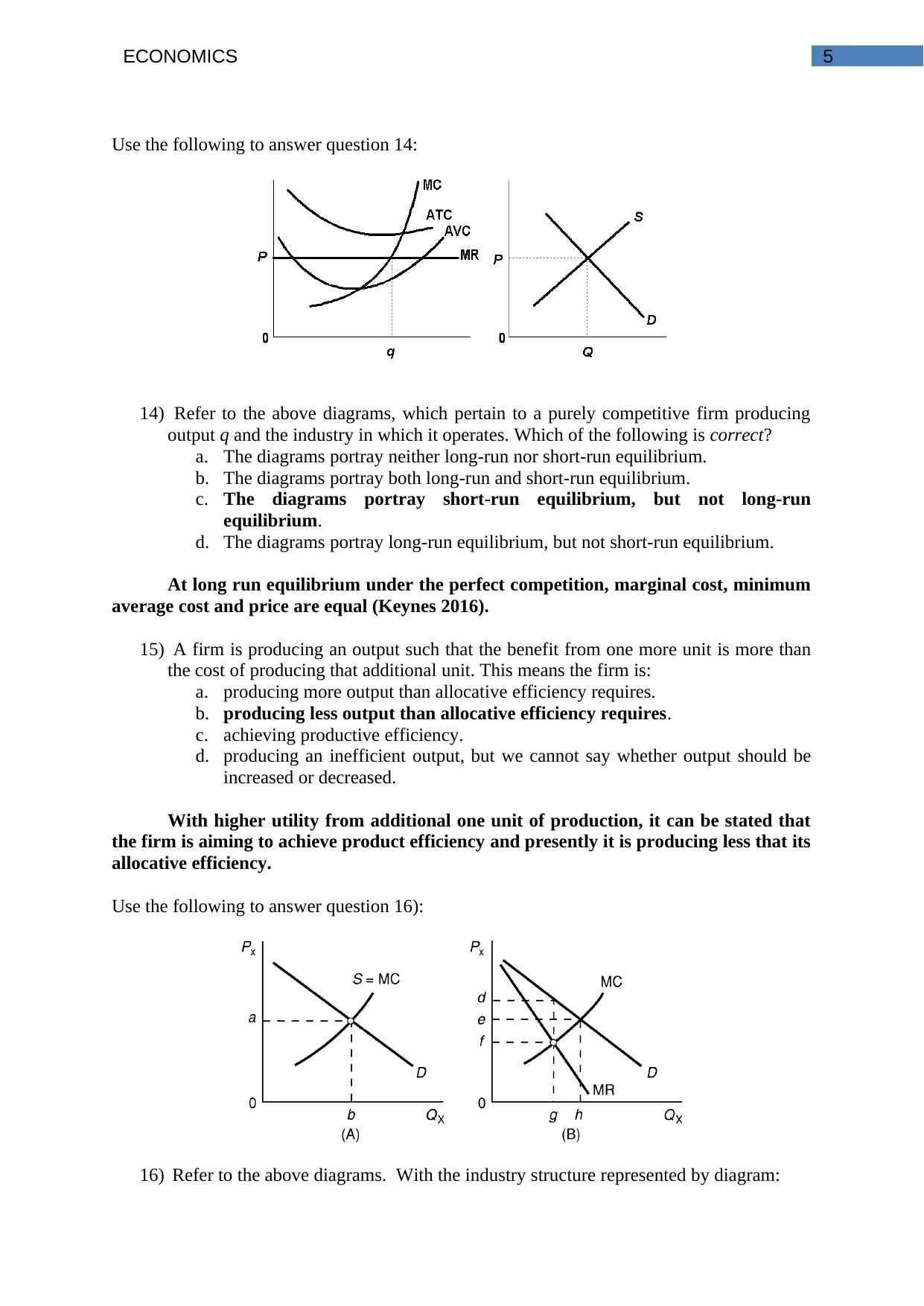
5ECONOMICS
Use the following to answer question 14:
14) Refer to the above diagrams, which pertain to a purely competitive firm producing
output q and the industry in which it operates. Which of the following is correct?
a. The diagrams portray neither long-run nor short-run equilibrium.
b. The diagrams portray both long-run and short-run equilibrium.
c. The diagrams portray short-run equilibrium, but not long-run
equilibrium.
d. The diagrams portray long-run equilibrium, but not short-run equilibrium.
At long run equilibrium under the perfect competition, marginal cost, minimum
average cost and price are equal (Keynes 2016).
15) A firm is producing an output such that the benefit from one more unit is more than
the cost of producing that additional unit. This means the firm is:
a. producing more output than allocative efficiency requires.
b. producing less output than allocative efficiency requires.
c. achieving productive efficiency.
d. producing an inefficient output, but we cannot say whether output should be
increased or decreased.
With higher utility from additional one unit of production, it can be stated that
the firm is aiming to achieve product efficiency and presently it is producing less that its
allocative efficiency.
Use the following to answer question 16):
16) Refer to the above diagrams. With the industry structure represented by diagram:
Use the following to answer question 14:
14) Refer to the above diagrams, which pertain to a purely competitive firm producing
output q and the industry in which it operates. Which of the following is correct?
a. The diagrams portray neither long-run nor short-run equilibrium.
b. The diagrams portray both long-run and short-run equilibrium.
c. The diagrams portray short-run equilibrium, but not long-run
equilibrium.
d. The diagrams portray long-run equilibrium, but not short-run equilibrium.
At long run equilibrium under the perfect competition, marginal cost, minimum
average cost and price are equal (Keynes 2016).
15) A firm is producing an output such that the benefit from one more unit is more than
the cost of producing that additional unit. This means the firm is:
a. producing more output than allocative efficiency requires.
b. producing less output than allocative efficiency requires.
c. achieving productive efficiency.
d. producing an inefficient output, but we cannot say whether output should be
increased or decreased.
With higher utility from additional one unit of production, it can be stated that
the firm is aiming to achieve product efficiency and presently it is producing less that its
allocative efficiency.
Use the following to answer question 16):
16) Refer to the above diagrams. With the industry structure represented by diagram:

6ECONOMICS
a. (A) there will be only a normal profit in the long run, while in (B) an
economic profit can persist.
b. (A) price exceeds marginal cost, resulting in allocative inefficiency.
c. (B) price equals marginal cost, resulting in allocative efficiency.
d. (B) equilibrium price and quantity will be e and h, respectively.
Considering the diagram it can be seen that price equates with the marginal cost.
In this situation, optimal distribution of the services and goods take place that aid the
economy to have allocative efficiency.
17) Suppose that an industry is characterized by a few firms and tacit collusion. We
would expect that:
a. Monopoly pricing will prevail and large profits will be received by firms.
b. One dominant firm will set prices and others will follow.
c. One firm will offer a price discount if any new entrant tries to undercut them
and other incumbents will follow.
d. All of the above.
Under tacit collusion firms minimize responses from the other firms that depicts
without saying so (Awaya and Krishna 2016). Though market may have many firms,
but they will operate as a group under tacit collusion leading to monopoly pricing.
18) Depletion of fish stocks through overfishing is a good example of the:
a. Coase theorem.
b. law of increasing returns.
c. tragedy of the commons.
d. law of conservation of matter and energy.
If a shared resource is being over exploited in order to fulfil own interest leading
to fall in the utility of the others, then it is called tragedy of the commons (Iizuka and
Katz 2017). If there is depletion of fish stock, then it would hamper the utility of the
other people thus it can be coined as tragedy of commons.
19) A negative externality or spillover cost occurs when:
a. firms fail to achieve allocative efficiency by under allocating resources.
b. firms fail to achieve productive efficiency.
c. price exceeds marginal cost.
d. the total cost of producing a good exceeds the costs borne by the
producer.
Negative externality takes place, when spill over of cost is there leading to rise in
cost to the producer is higher than the cost of production and negatively affects the
society.
a. (A) there will be only a normal profit in the long run, while in (B) an
economic profit can persist.
b. (A) price exceeds marginal cost, resulting in allocative inefficiency.
c. (B) price equals marginal cost, resulting in allocative efficiency.
d. (B) equilibrium price and quantity will be e and h, respectively.
Considering the diagram it can be seen that price equates with the marginal cost.
In this situation, optimal distribution of the services and goods take place that aid the
economy to have allocative efficiency.
17) Suppose that an industry is characterized by a few firms and tacit collusion. We
would expect that:
a. Monopoly pricing will prevail and large profits will be received by firms.
b. One dominant firm will set prices and others will follow.
c. One firm will offer a price discount if any new entrant tries to undercut them
and other incumbents will follow.
d. All of the above.
Under tacit collusion firms minimize responses from the other firms that depicts
without saying so (Awaya and Krishna 2016). Though market may have many firms,
but they will operate as a group under tacit collusion leading to monopoly pricing.
18) Depletion of fish stocks through overfishing is a good example of the:
a. Coase theorem.
b. law of increasing returns.
c. tragedy of the commons.
d. law of conservation of matter and energy.
If a shared resource is being over exploited in order to fulfil own interest leading
to fall in the utility of the others, then it is called tragedy of the commons (Iizuka and
Katz 2017). If there is depletion of fish stock, then it would hamper the utility of the
other people thus it can be coined as tragedy of commons.
19) A negative externality or spillover cost occurs when:
a. firms fail to achieve allocative efficiency by under allocating resources.
b. firms fail to achieve productive efficiency.
c. price exceeds marginal cost.
d. the total cost of producing a good exceeds the costs borne by the
producer.
Negative externality takes place, when spill over of cost is there leading to rise in
cost to the producer is higher than the cost of production and negatively affects the
society.
Paraphrase This Document
Need a fresh take? Get an instant paraphrase of this document with our AI Paraphraser
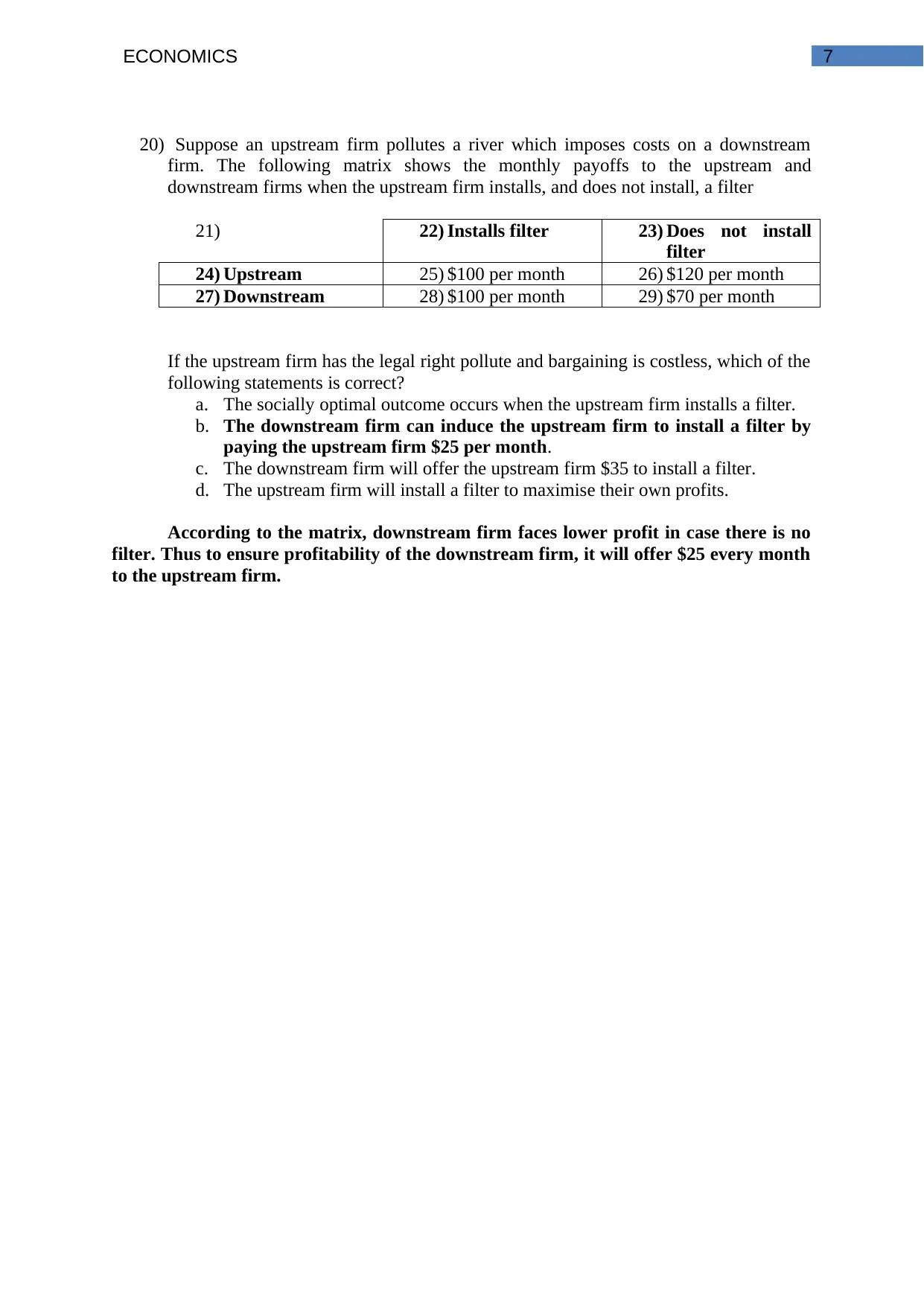
7ECONOMICS
20) Suppose an upstream firm pollutes a river which imposes costs on a downstream
firm. The following matrix shows the monthly payoffs to the upstream and
downstream firms when the upstream firm installs, and does not install, a filter
21) 22) Installs filter 23) Does not install
filter
24) Upstream 25) $100 per month 26) $120 per month
27) Downstream 28) $100 per month 29) $70 per month
If the upstream firm has the legal right pollute and bargaining is costless, which of the
following statements is correct?
a. The socially optimal outcome occurs when the upstream firm installs a filter.
b. The downstream firm can induce the upstream firm to install a filter by
paying the upstream firm $25 per month.
c. The downstream firm will offer the upstream firm $35 to install a filter.
d. The upstream firm will install a filter to maximise their own profits.
According to the matrix, downstream firm faces lower profit in case there is no
filter. Thus to ensure profitability of the downstream firm, it will offer $25 every month
to the upstream firm.
20) Suppose an upstream firm pollutes a river which imposes costs on a downstream
firm. The following matrix shows the monthly payoffs to the upstream and
downstream firms when the upstream firm installs, and does not install, a filter
21) 22) Installs filter 23) Does not install
filter
24) Upstream 25) $100 per month 26) $120 per month
27) Downstream 28) $100 per month 29) $70 per month
If the upstream firm has the legal right pollute and bargaining is costless, which of the
following statements is correct?
a. The socially optimal outcome occurs when the upstream firm installs a filter.
b. The downstream firm can induce the upstream firm to install a filter by
paying the upstream firm $25 per month.
c. The downstream firm will offer the upstream firm $35 to install a filter.
d. The upstream firm will install a filter to maximise their own profits.
According to the matrix, downstream firm faces lower profit in case there is no
filter. Thus to ensure profitability of the downstream firm, it will offer $25 every month
to the upstream firm.
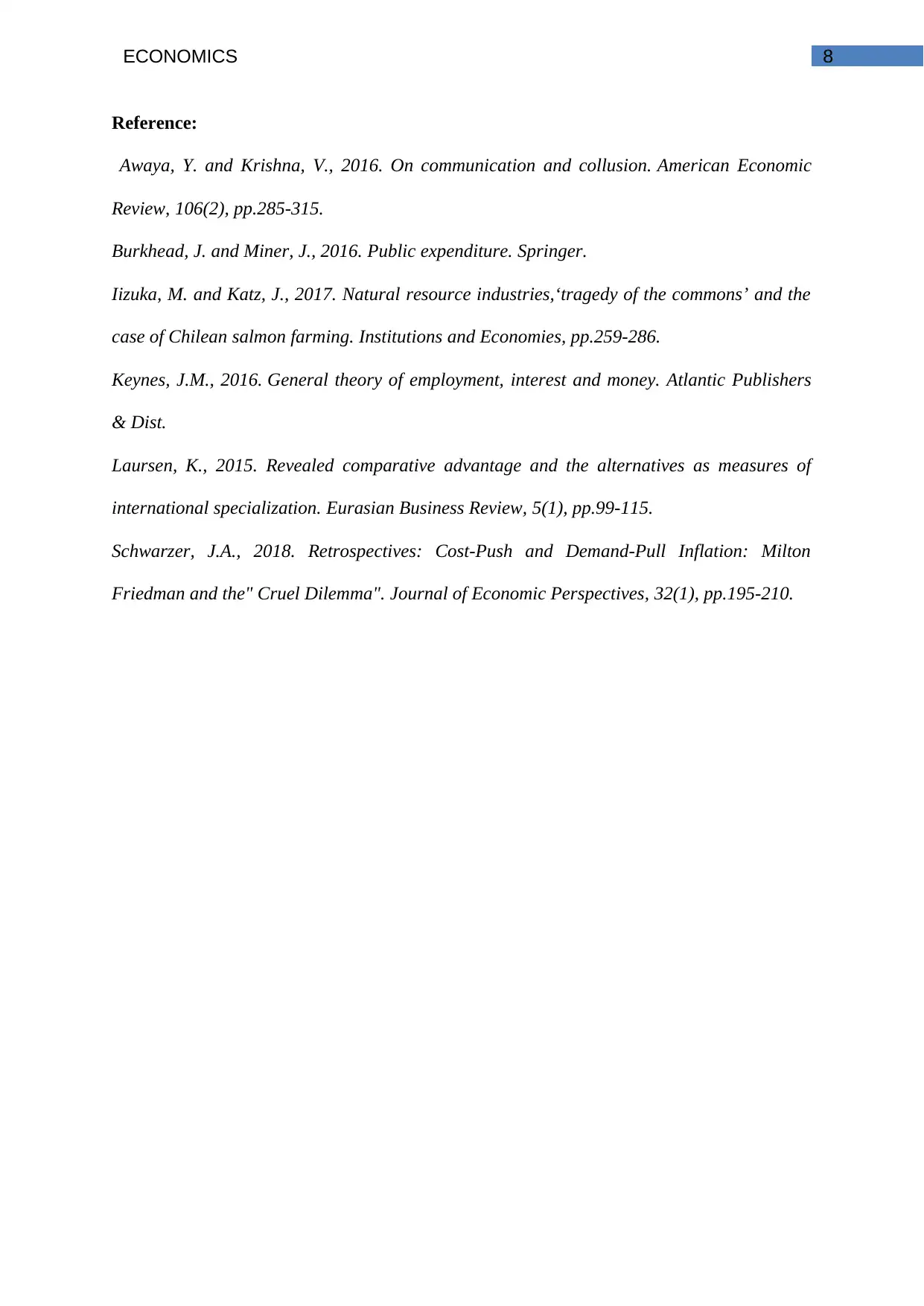
8ECONOMICS
Reference:
Awaya, Y. and Krishna, V., 2016. On communication and collusion. American Economic
Review, 106(2), pp.285-315.
Burkhead, J. and Miner, J., 2016. Public expenditure. Springer.
Iizuka, M. and Katz, J., 2017. Natural resource industries,‘tragedy of the commons’ and the
case of Chilean salmon farming. Institutions and Economies, pp.259-286.
Keynes, J.M., 2016. General theory of employment, interest and money. Atlantic Publishers
& Dist.
Laursen, K., 2015. Revealed comparative advantage and the alternatives as measures of
international specialization. Eurasian Business Review, 5(1), pp.99-115.
Schwarzer, J.A., 2018. Retrospectives: Cost-Push and Demand-Pull Inflation: Milton
Friedman and the" Cruel Dilemma". Journal of Economic Perspectives, 32(1), pp.195-210.
Reference:
Awaya, Y. and Krishna, V., 2016. On communication and collusion. American Economic
Review, 106(2), pp.285-315.
Burkhead, J. and Miner, J., 2016. Public expenditure. Springer.
Iizuka, M. and Katz, J., 2017. Natural resource industries,‘tragedy of the commons’ and the
case of Chilean salmon farming. Institutions and Economies, pp.259-286.
Keynes, J.M., 2016. General theory of employment, interest and money. Atlantic Publishers
& Dist.
Laursen, K., 2015. Revealed comparative advantage and the alternatives as measures of
international specialization. Eurasian Business Review, 5(1), pp.99-115.
Schwarzer, J.A., 2018. Retrospectives: Cost-Push and Demand-Pull Inflation: Milton
Friedman and the" Cruel Dilemma". Journal of Economic Perspectives, 32(1), pp.195-210.
1 out of 9
Related Documents
Your All-in-One AI-Powered Toolkit for Academic Success.
+13062052269
info@desklib.com
Available 24*7 on WhatsApp / Email
![[object Object]](/_next/static/media/star-bottom.7253800d.svg)
Unlock your academic potential
© 2024 | Zucol Services PVT LTD | All rights reserved.




